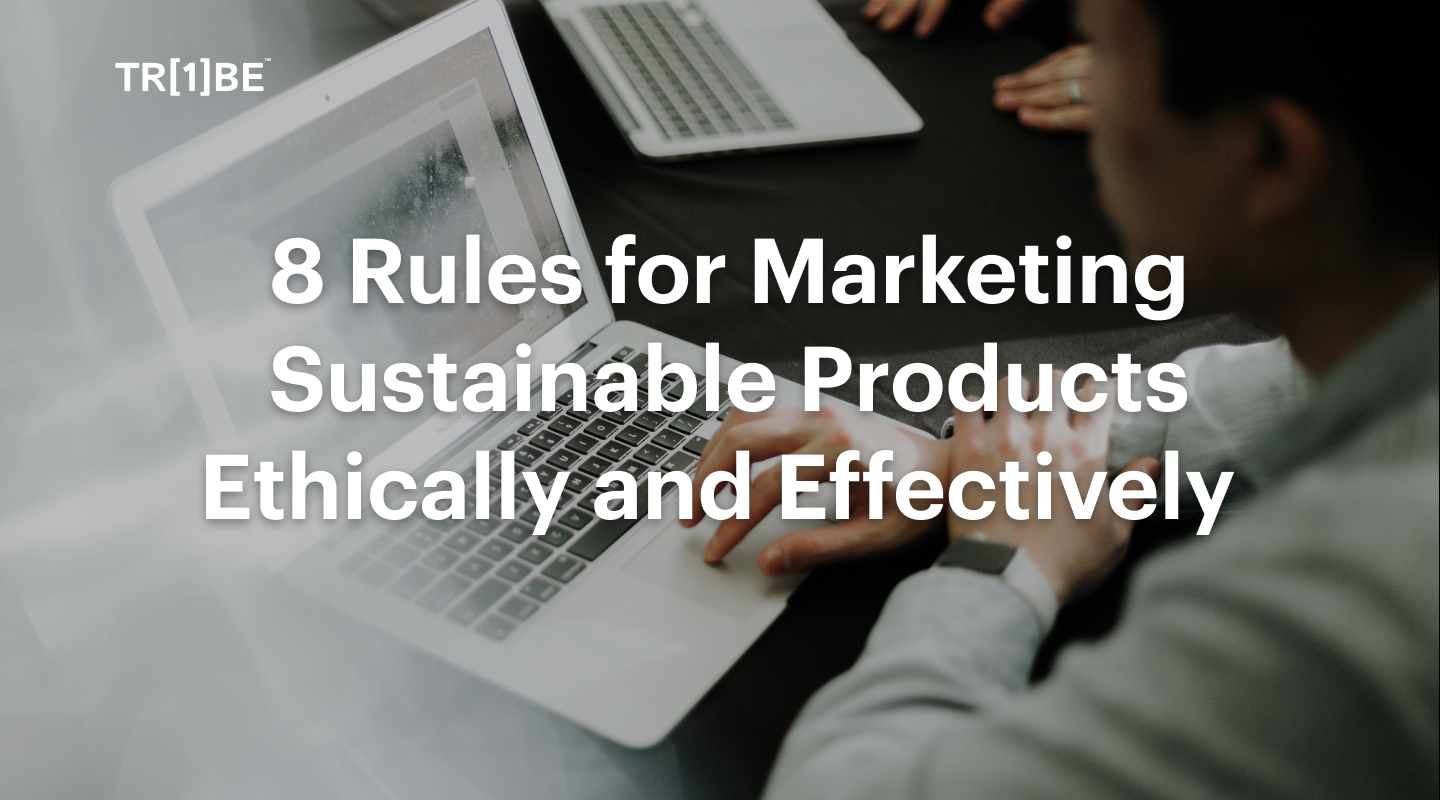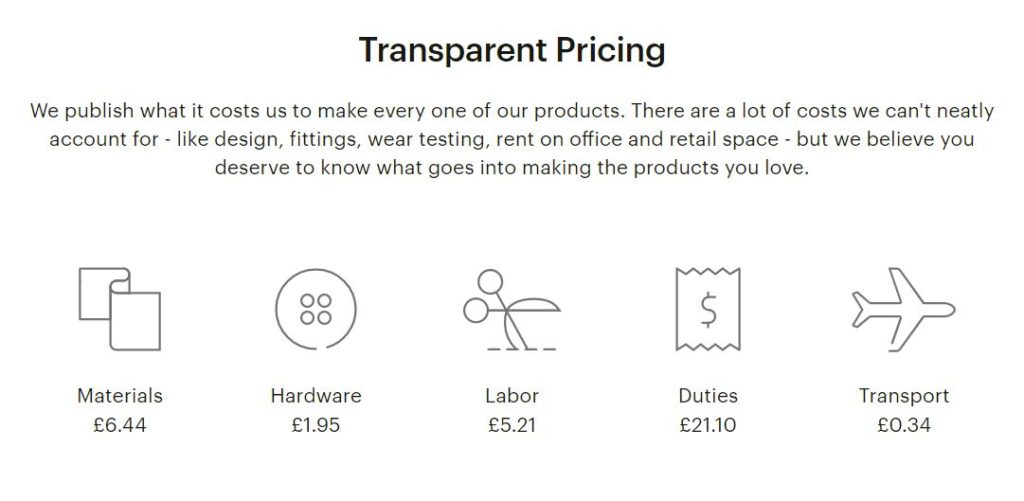
Wondering how to approach sustainable marketing? We explain the best way to market sustainability and showcase what ethical brands are doing that you might be missing…
Choosing to make and market sustainable products is an admirable choice. But just as creating a sustainable product is often more challenging than choosing the path of least resistance, marketing sustainable products can be a unique challenge, too.
Here are 8 useful rules for marketers on how to ethically and effectively market your sustainable products.
Ethical consumers are often skeptical consumers — and with good reason. Don’t feel the need to exaggerate your product’s impact or benefits to appeal to them. Many ethical consumers are just looking for a better choice, not a perfect one. Being honest and speaking plainly is a great way to earn credibility and show them just that.
Impact reports are often a great way of communicating your environmental efforts. They give insight into brands development areas and ways of working. Most eco-centric brands will produce one on a yearly basis and will share it publicly. Often containing insights on their social and environmental impact, their achievements, and what they are working on to guarantee a more sustainable future.

Many consumers and advocates of sustainable products are interested in more than just environmental justice. Concerns about your workers’ rights, supply chain, and corporate values are often just as important to your consumers. So, where applicable — on places like product pages, long-form content and disclaimers — don’t forget to mention these details and explain why they are the way they are. If your process is in great shape, you’ll win points with your consumers. If it’s not ideal, but you explain that you’re working toward a better solution or that there just isn’t one, you’ll earn points for honesty.
A rule to remember: Whatever you don’t tell a skeptical consumer, they’ll imagine for themselves. And with all the greenwashers and grifters out there, their imagination will often be worse than reality. Veja, an ethical shoe brand, explained its production process end to end for interested consumers and investors. It was a great visualisation of the efforts they are making across their supply chain.

At the end of the day, you’re creating an advertisement or a piece of marketing content, so it must follow the same best practices: Focus on the problem you’re solving, the value to the consumer AND the value to the environment. Otherwise, you’ll miss any consumer’s biggest question: “What’s in it for me?”
Your product can only make a difference if your company succeeds, so don’t feel bad about prioritising benefits over politics when it’s appropriate.

A good rule of thumb for sustainable marketers is that if you avoid the cost question, someone else will answer it for you. So, why not contribute to that conversation yourself? Explain the cost transparently, put it in context of the environmental benefit/trade-off and let the consumer decide for themselves if that’s worth it.

A common mistake that sustainable product marketers make is talking about the statistics around how many consumers want sustainable products or how much of a market there is for this. While this makes sense if you’re looking to raise funds or speaking to your investors, consumers don’t care. If they want sustainable products, they already know that. Focus on the value to them and the environment.

If you’re a brand making a sustainable product, then there’s a beautiful story to tell. Whether that’s in a blog post, a values or about us page or something more engaging like a video, find a place to go in-depth on your product. Buyers love to know more and often seek content — like online reviews, videos or blogs — to learn more about even small potential purchases. Not every product page or banner ad will have room for this, but it still belongs somewhere.
If you’re a reseller, then featuring this type of info on the product page can be helpful for conversion and transparency.
Whether you’re a marketer or just a person sharing a story about a sustainable product you love, you’ll attract nay-sayers who say things like, “I’m not paying more for that!” or “I bet that doesn’t even make a difference!” How you respond to these comments is a huge opportunity for your brand — and a huge potential risk if you fumble it.
Depending on your brand voice, you may want to be kind and understanding or humorous and snarky. Either way, don’t forget to reply with facts and answer the question at the core of the comment. Even friendly users will notice if you dodge a question, and for social media marketers, a well crafted response can earn even more credibility and positive sentiment than a well crafted ad.

Many people who make and market sustainable products are champions of a broader lifestyle of sustainability. However, you shouldn’t assume or comment on other aspects of the customer’s lifestyle just because they’re interested in your product. For example, eating meat is considered by many environmentalists to be unsustainable. However, just because someone is interested in your reusable shopping bag, doesn’t mean they’re interested in veganism. (Maybe one day!)
So, make sure you’re not injecting your ads, website or marketing content with extraneous socio-political messages, because you may turn off well meaning consumers who disagree with you on other points of sustainable living.
Some of the best marketing is reputational marketing — so living up to those sustainable values as a company is a great way to both lessen your negative impact and better your brand.
Showing your customers that you’re serious about your values is a great way of instilling confidence in an age of consumer skepticism. Run your marketing, production and business sustainably and you’ll build a loyal following of ethical consumers- guaranteed.
Sustainable products, selling sustainable products, how to market sustainable products, how to improve your sustainable marketing, sustainable marketing ideas, sustainable products marketing, sustainable marketing, responsible sales, responsible products marketing, what does sustainable marketing involve, how to make sure you are marketing products sustainably, ways that brands are marketing their products sustainably
One Tribe is a Climate Action Platform enabling businesses and their customers to make a positive environmental impact.



Eric currently works as an independent consultant at the intersection of nature and climate, focused on catalysing market and non-market solutions to drive the just transition.
He previously was Head of Product at Earthshot Labs, supporting nature conservation and restoration projects across the global south secure project finance. Prior to Earthshot Labs, Eric led nature-based carbon project development for Gorongosa National Park in Mozambique and founded the Carbon Cooperative, a global alliance of leading nature conservation and restoration practitioners exploring carbon finance. After serving in the Peace Corps in Mozambique out of university, he spent much of his 20s working in community-based conservation and ecosystem restoration efforts in Sub-Saharan Africa interspersed with two startup ventures as co-founder and CEO of a mental health tech startup and COO of a sustainable coffee company. Eric has a dual Masters in Environmental Engineering and Environmental Policy from Stanford University where he was a NSF Graduate Research Fellow and a BS in Environmental Engineering from Tufts University.
Alan is a risk management thought-leader, superconnector, and FinTech pioneer. His mission is to enable an Earth Positive economy which includes nature in global accounting systems.
Alan is Founder of Generation Blue, a venture studio dedicated to planetary game changers powered by exponential technologies. Previously, Alan established Natural Capital Markets at Lykke AG, pioneering blockchain based forestry and carbon backed tokens. Alan has over two decades of risk management experience advising global financial institutions, and was a founding member of the RiskMetrics Group, a JPMorgan spin-off. Alan is an investor and advisor to regenerative impact ventures, including TreeBuddy.Earth, Regenativ, and Vlinder Climate.
Lori Whitecalf made history when she became the first woman to be elected Chief of Sweetgrass First Nation in 2011. She served three terms of office from 2011-2017.
Lori took a two-year hiatus from leadership to expand the family ranch and serve as the FSIN Senior Industry Liaison. She was re-elected on November 29. 2019 and again on November 30, 2021, as Chief of Sweetgrass. Chief Whitecalf practises a traditional lifestyle of hunting, fishing and gathering. She currently sits on the following boards: Saskatchewan Indian Institute of Technology, FSIN Lands and Resource Commission, Battle River Treaty 6 Health Centre and Battleford Agency Tribal Chiefs Executive Council, FSIN Women’s Commission.
Tina is the Chief Business Officer for MLTC Industrial Investments, the Economic Development arm of the Meadow Lake Tribal Council. She has a diverse background of experience. Having spent 15 years as a municipal Chief Operating Officer, 20 years involved in Saskatchewan’s Health Authority Board Keewatin Yatthe and 9 years with Northern Lights Board of Education.
She continues as a Board Member with Beaver River Community Futures supporting small business development in her home region. Tina brings a wealth of experience in a variety of fields and many connections to the Indigenous communities of Northern Saskatchewan. In addition Tina holds a BA Advanced from the U of S, a Certificate in Local Government Authority from the U of R and is certified as a Professional Economic Developer for Saskatchewan and a certified Technician Aboriginal Economic Developer (TAED).
Tootoosis’ career spans 40+ years in HRM, political leadership, and Indigenous economic development, as a dedicated bridge builder and advocate for Indigenous causes.
As a key member of the Saskatoon Regional Economic Development Authority (SREDA) team since 2021, he develops strategies for the Truth and Reconciliation Commission final report and Call to Action #92.
He is a graduate of the First Nations University of Canada and a certified Professional Aboriginal Economic Developer. Spearheading various community initiatives while serving as a Chair of the SIEDN while directing ILDII and WIBF. Founder of MGT Consulting Tootoosis is based in Saskatoon, Treaty Six Territory.
Cy Standing (Wakanya Najin in Dakota) has a long and distinguished career including serving overseas as an Electronics Technician in the Royal Canadian Air Force, former Chief of Wahpeton Dakota Nation, former Vice Chief of the Federation of Saskatchewan Indigenous Nations (FSIN), past Executive Director of Community Development Branch of the Department of Northern Saskatchewan as well as an Order in Council appointment to the Federal Parole Board.
Mr. Standing has served as a Director on many Profit and Non-Profit Corporate Boards, including serving as a Director for Affinity Credit Union with assets of over six billion dollars as well as IMI Brokerage and Wanuskewin and is currently a member of the One Tribe Indigenous Carbon Board.